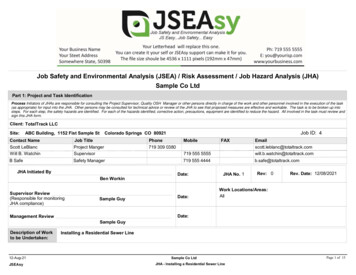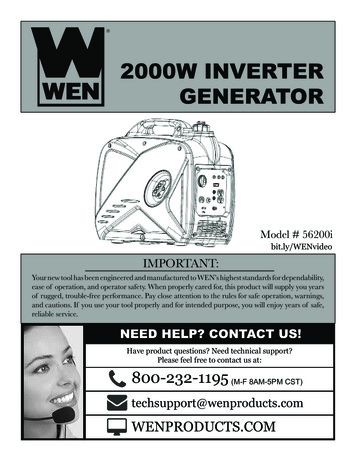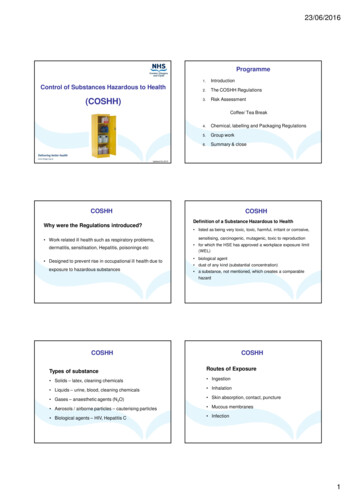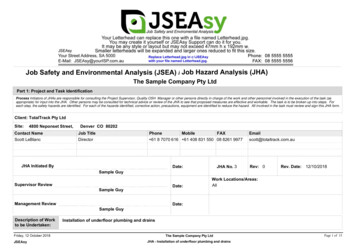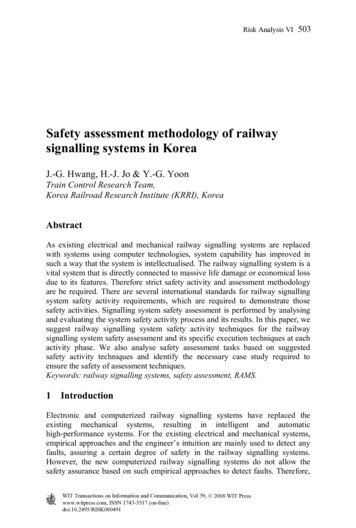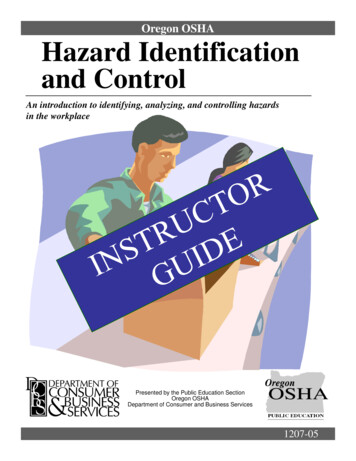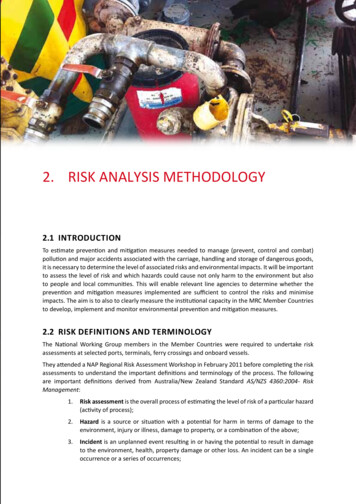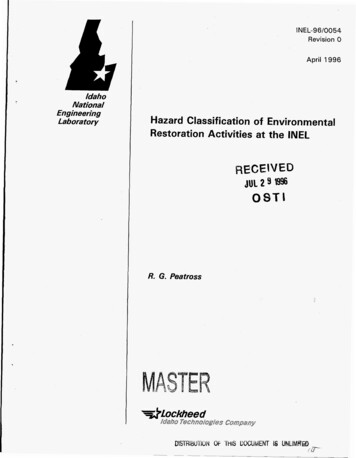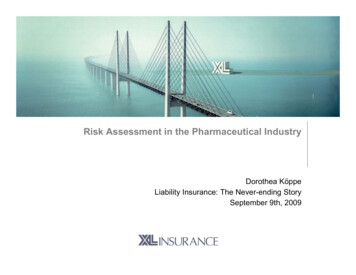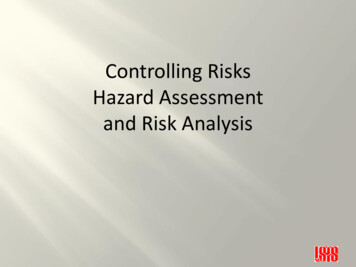
Transcription
Controlling RisksHazard Assessmentand Risk Analysis
Analysis PhaseRisk analysis and protection layer designAllocation of safety functionsto safety instrumented systemsor other means of risk reductionManagementof functionalSafety ningSafety requirementsspecificationfor the SISDesign and developmentofOther means of riskreductionDesign and developmentofSafety InstrumentedSystemInstallation, commissioning, and validationOperation and maintenanceModificationUSPAS January 2012DecommissioningControlling Risks: Safety SystemsVerification
Most encountered words from seniormanagement?“I do not want any surprises”Hazard and risk analysisare a means to that end USPAS January 2012Controlling Risks: Safety Systems
Hazard Analysis Hazard analysis uncovers and identifies hazards that exist in theworkplace, generally focusing on a particular activity, project, or system. Basic information for risk based decisions Develop a means to:– Communicate– Track– Quantify– Allocate mitigation measures– Verify effectiveness Hazard analysis can also be referred to as hazard recognition, based uponthe above definition.USPAS January 2012Controlling Risks: Safety Systems
Standards - IEC61508 (part 7.4) determine the hazards and hazardousevents of the EUC and the EUC control system (inall modes of operation) for all reasonablyforeseeable circumstances, including faultconditions and misuse. determine the event sequences leading to thehazardous events determined by the analysis. determine the EUC risks associated with thehazardous events determined by the analysis.*EUC Equipment Under ControlUSPAS January 2012Controlling Risks: Safety Systems
Anticipate Hazard assessment of a proposed facility orsystem should occur before design criteria orother, less formal work-description documentsare drafted, ideally even before initialconcepts are finalized.USPAS January 2012Controlling Risks: Safety Systems
Definitions Hazard – a state or set of conditions of asystem (or an object) that, together with otherconditions in the environment of the system(or object), will lead inevitably to an accident(loss event). Hazard Level – the combination of severity andlikelihood of occurrenceUSPAS January 2012Controlling Risks: Safety Systems
Definitions - continued Accident – an undesired and unplanned (but notnecessarily unexpected) event that results in (atleast) a specified level of loss. Mishap – Department of Defense term foraccident which is defined as an unwanted oruncontrolled release of energy or a toxicexposure. Near miss/incident – an event that involves noloss (or only minor loss) but with the potential forloss under different circumstances.USPAS January 2012Controlling Risks: Safety Systems
Definitions - continued Safety – freedom from accidents or losses Reliability – the probability that a piece ofequipment or component will perform itsintended function satisfactorily for a prescribedtime under stipulated environmental conditions. Error – a design flaw or deviation from a desiredor intended state.USPAS January 2012Controlling Risks: Safety Systems
Definitions - continued Severity of occurrence – the worst possibleaccident that could result from the hazard giventhe environment in its most unfavorable state. Probability, or likelihood of occurrence – may bespecified either quantitatively or qualitatively. Mishap probability – is the probability that amishap will occur during the planned lifeexpectancy of the system. [MIL-STD-882D]USPAS January 2012Controlling Risks: Safety Systems
Definitions - continued Risk – is the hazard level combined with (1) thelikelihood of the hazard leading to an accident(sometimes called danger) and (2) hazard exposureor duration (sometimes called latency).– Correct way to combine all elements of risk is unknown– Parameter values of each function are also unknown– No agreement on how to combine probability, severity andnon-probabilistic factors– Comparison of catastrophic but unlikely events with likelybut less serious events is unknown– Must involve qualitative judgment and personal valuesUSPAS January 2012Controlling Risks: Safety Systems
Definitions - continued Hazard Analysis – the identification of hazards andthe assessment of hazard level. Risk Analysis – includes hazard analysis plus theaddition of identification and assessment ofenvironmental conditions along with exposure orduration.– Often used interchangeably with hazard analysis– Reliability often used incorrectly as a measure of riskUSPAS January 2012Controlling Risks: Safety Systems
The Risk ComponentsUSPAS January 2012Controlling Risks: Safety Systems
Factors Affecting Risk Components– Introduction of new hazards– Lessons learned that are passed down through codes andstandards of practice for known hazards– New engineering specializations and technologies forwhich codes & standards have not been developed.– Older, simpler technologies are replaced w/ newer, morecomplex technologies.USPAS January 2012Controlling Risks: Safety Systems
Factors Affecting Risk Components Increasing complexity of Pace of technological change in the systemUSPAS January 2012Controlling Risks: Safety Systems
Hazard Assessment: Identification Identify hazards and the possible accidentsthat might result from each hazard.– Process should be systematic– Entail analysis of hazard modality– Evaluate environment in which it will exist– Include intended use or applicationUSPAS January 2012Controlling Risks: Safety Systems
Hazard Identification Processes Preliminary Hazard Assessment (PHA) Preliminary Safety Assessment Review (PSAR) Safety Assessment Document (SAD)USPAS January 2012Controlling Risks: Safety Systems
Hazard Management LifecycleUSPAS January 2012Controlling Risks: Safety Systems
Hazard Identification Sources Sources of information– Historical hazard and mishap data Accidents Occurrence events– Lessons learned from other systems– Hazards that occur over the lifetime of the system Mean time to failure of system componentsUSPAS January 2012Controlling Risks: Safety Systems
USPAS January 2012Controlling Risks: Safety Systems
Classroom Exercise 32 MeV accelerator– Gun deck– Steering magnets– RF section Experimental Cave– Steering magnets– RF section– Experimental targetUSPAS January 2012Controlling Risks: Safety Systems
Documentation Records of hazard reviews should be incorporatedinto the overall project design documentation.– It preserves your methods and rationale so thatyou are able to undertake a comparable review moreefficiently in the future.– It provides a defensible basis for your system during apermitting or agency review.– It augments the customary discipline found ingood engineering and architectural design practicesUSPAS January 2012Controlling Risks: Safety Systems
Analysis Phase Ma n a g e m e n t o f fu n c tio n a l S a fe ty a n d S a fe ty a s s e s s m e n t S a fe ty L ife c y c le S tru c tu r e a n d
